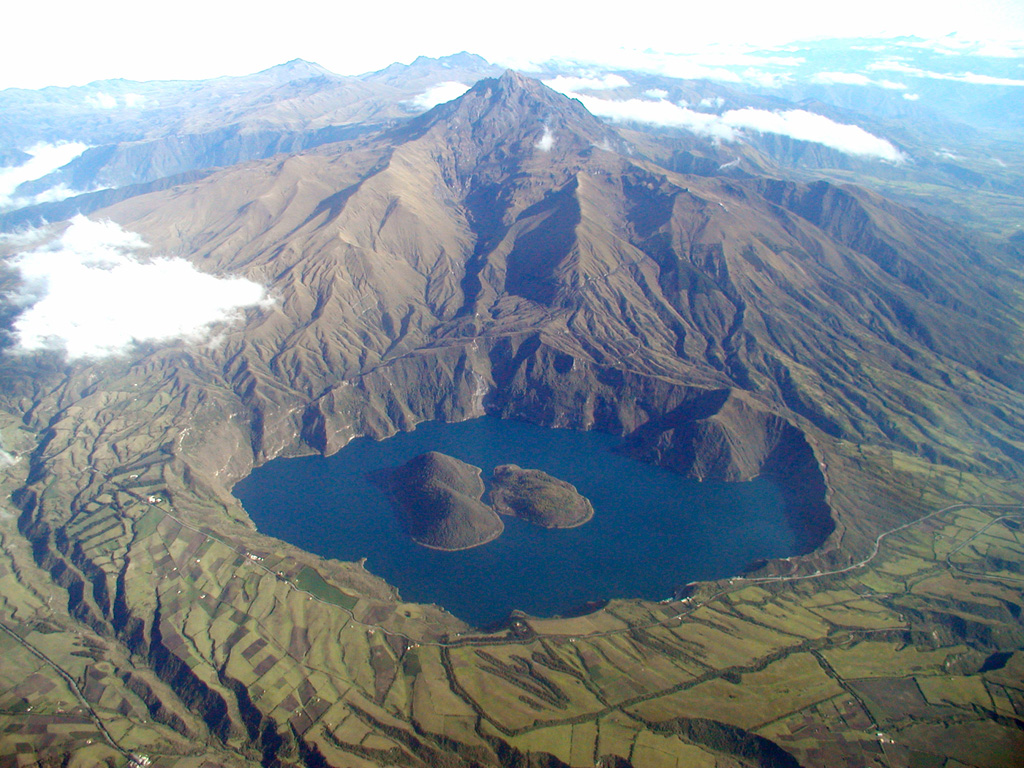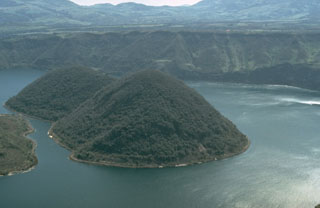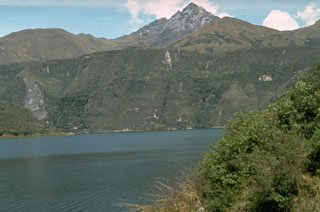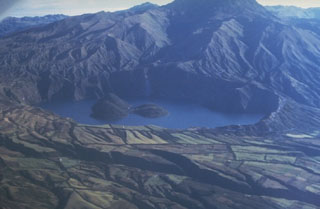

IG reported that, after an earthquake swarm consisting of 62 volcano-tectonic events during 2-3 October, seismicity at Cuicocha returned to background levels on 4 October. Carbon dioxide levels were normal, and deformation data did not show any anomalies.
Source: Instituto Geofísico-Escuela Politécnica Nacional (IG-EPN)
2018: October
IG reported that, after an earthquake swarm consisting of 62 volcano-tectonic events during 2-3 October, seismicity at Cuicocha returned to background levels on 4 October. Carbon dioxide levels were normal, and deformation data did not show any anomalies.
Source: Instituto Geofísico-Escuela Politécnica Nacional (IG-EPN)
IG reported an increase in seismic activity at Cuicocha during 2-3 October, characterized by a total of 60 volcano-tectonic events recorded at the time of the report posting. The largest of these events, a M 2.5 at 1058 on 2 October, was reportedly slightly felt by a resident of Quiroga.
Source: Instituto Geofísico-Escuela Politécnica Nacional (IG-EPN)
The Global Volcanism Program has no Bulletin Reports available for Cuicocha.
This compilation of synonyms and subsidiary features may not be comprehensive. Features are organized into four major categories: Cones, Craters, Domes, and Thermal Features. Synonyms of features appear indented below the primary name. In some cases additional feature type, elevation, or location details are provided.
Domes |
||||
| Feature Name | Feature Type | Elevation | Latitude | Longitude |
| Teodoro Wolf, Isla | Dome | |||
| Yerovi, Isla | Dome | |||
|
|
||||||||||||||||||||||||
There is data available for 4 confirmed Holocene eruptive periods.
0650 (?) Confirmed Eruption
| Episode 1 | Eruption Episode | |||||||||||||||
|---|---|---|---|---|---|---|---|---|---|---|---|---|---|---|---|
| 0650 (?) - Unknown | Evidence from Isotopic: 14C (uncalibrated) | ||||||||||||||
|
List of 1 Events for Episode 1
| |||||||||||||||
0950 BCE (?) Confirmed Eruption
| Episode 1 | Eruption Episode | |||||||||||||||||||||||||
|---|---|---|---|---|---|---|---|---|---|---|---|---|---|---|---|---|---|---|---|---|---|---|---|---|---|
| 0950 BCE (?) - Unknown | Evidence from Isotopic: 14C (uncalibrated) | ||||||||||||||||||||||||
|
List of 3 Events for Episode 1
| |||||||||||||||||||||||||
1150 BCE ± 150 years Confirmed Eruption Max VEI: 5
| Episode 1 | Eruption Episode | |||||||||||||||||||||||||||||||||||||||||||||
|---|---|---|---|---|---|---|---|---|---|---|---|---|---|---|---|---|---|---|---|---|---|---|---|---|---|---|---|---|---|---|---|---|---|---|---|---|---|---|---|---|---|---|---|---|---|
| 1150 BCE ± 150 years - Unknown | Evidence from Isotopic: 14C (uncalibrated) | ||||||||||||||||||||||||||||||||||||||||||||
|
List of 7 Events for Episode 1
| |||||||||||||||||||||||||||||||||||||||||||||
2550 BCE (?) Confirmed Eruption
| Episode 1 | Eruption Episode | ||||||||||||||||||||
|---|---|---|---|---|---|---|---|---|---|---|---|---|---|---|---|---|---|---|---|---|
| 2550 BCE (?) - Unknown | Evidence from Isotopic: 14C (uncalibrated) | |||||||||||||||||||
|
List of 2 Events for Episode 1
| ||||||||||||||||||||
There is no Deformation History data available for Cuicocha.
There is no Emissions History data available for Cuicocha.
 An explosive eruption about 2900 years ago produced widespread tephra and pyroclastic surges. Subsequently a group of four dacitic lava domes was constructed within Cuicocha caldera. This marks the latest known activity from the caldera. The eastern two domes are seen here from the SE rim of the caldera. The lava domes form two forested islands in the center of the 3-km-wide caldera.
An explosive eruption about 2900 years ago produced widespread tephra and pyroclastic surges. Subsequently a group of four dacitic lava domes was constructed within Cuicocha caldera. This marks the latest known activity from the caldera. The eastern two domes are seen here from the SE rim of the caldera. The lava domes form two forested islands in the center of the 3-km-wide caldera. Sharp-peaked Cotacachi stratovolcano rises above the caldera lake of Cuicocha volcano. The northern caldera wall truncates the flank of the heavily eroded Cotacachi. The caldera was formed during powerful explosive eruptions about 3100 years ago that produced 4.8 cu km of pumice-rich pyroclastic flows and airfall tephra that blanket the surrounding countryside.
Sharp-peaked Cotacachi stratovolcano rises above the caldera lake of Cuicocha volcano. The northern caldera wall truncates the flank of the heavily eroded Cotacachi. The caldera was formed during powerful explosive eruptions about 3100 years ago that produced 4.8 cu km of pumice-rich pyroclastic flows and airfall tephra that blanket the surrounding countryside. Scenic lake-filled Cuicocha caldera is located at the southern foot of the sharp-peaked Pleistocene Cotacachi stratovolcano. The caldera was created about 3100 years ago and contains a cluster of intra-caldera dacitic lava domes that form two islands in the large lake. A pre-caldera Cuicocha lava dome is situated on the east side of the lake (right). Pyroclastic-flow deposits cover wide areas around the volcano. The northern caldera rim truncates the heavily eroded slopes of Cotocachi volcano.
Scenic lake-filled Cuicocha caldera is located at the southern foot of the sharp-peaked Pleistocene Cotacachi stratovolcano. The caldera was created about 3100 years ago and contains a cluster of intra-caldera dacitic lava domes that form two islands in the large lake. A pre-caldera Cuicocha lava dome is situated on the east side of the lake (right). Pyroclastic-flow deposits cover wide areas around the volcano. The northern caldera rim truncates the heavily eroded slopes of Cotocachi volcano.  The scenic lake-filled Cuicocha caldera is located at the southern foot of the sharp-peaked Pleistocene Cotacachi stratovolcano (top center) about 100 km north of Quito. Farmer's fields encroach on the rim of the 3-km-wide caldera, which was created during a major explosive eruption about 3100 years ago. Dacitic lava domes form two forested islands in the caldera lake. Pyroclastic-flow deposits from the caldera-forming eruptions cover wide areas in now populated areas below the low-rimmed caldera.
The scenic lake-filled Cuicocha caldera is located at the southern foot of the sharp-peaked Pleistocene Cotacachi stratovolcano (top center) about 100 km north of Quito. Farmer's fields encroach on the rim of the 3-km-wide caldera, which was created during a major explosive eruption about 3100 years ago. Dacitic lava domes form two forested islands in the caldera lake. Pyroclastic-flow deposits from the caldera-forming eruptions cover wide areas in now populated areas below the low-rimmed caldera. The maps shown below have been scanned from the GVP map archives and include the volcano on this page. Clicking on the small images will load the full 300 dpi map. Very small-scale maps (such as world maps) are not included. The maps database originated over 30 years ago, but was only recently updated and connected to our main database. We welcome users to tell us if they see incorrect information or other problems with the maps; please use the Contact GVP link at the bottom of the page to send us email.
There are no samples for Cuicocha in the Smithsonian's NMNH Department of Mineral Sciences Rock and Ore collection.
| Copernicus Browser | The Copernicus Browser replaced the Sentinel Hub Playground browser in 2023, to provide access to Earth observation archives from the Copernicus Data Space Ecosystem, the main distribution platform for data from the EU Copernicus missions. |
| MIROVA | Middle InfraRed Observation of Volcanic Activity (MIROVA) is a near real time volcanic hot-spot detection system based on the analysis of MODIS (Moderate Resolution Imaging Spectroradiometer) data. In particular, MIROVA uses the Middle InfraRed Radiation (MIR), measured over target volcanoes, in order to detect, locate and measure the heat radiation sourced from volcanic activity. |
| MODVOLC Thermal Alerts | Using infrared satellite Moderate Resolution Imaging Spectroradiometer (MODIS) data, scientists at the Hawai'i Institute of Geophysics and Planetology, University of Hawai'i, developed an automated system called MODVOLC to map thermal hot-spots in near real time. For each MODIS image, the algorithm automatically scans each 1 km pixel within it to check for high-temperature hot-spots. When one is found the date, time, location, and intensity are recorded. MODIS looks at every square km of the Earth every 48 hours, once during the day and once during the night, and the presence of two MODIS sensors in space allows at least four hot-spot observations every two days. Each day updated global maps are compiled to display the locations of all hot spots detected in the previous 24 hours. There is a drop-down list with volcano names which allow users to 'zoom-in' and examine the distribution of hot-spots at a variety of spatial scales. |
|
WOVOdat
Single Volcano View Temporal Evolution of Unrest Side by Side Volcanoes |
WOVOdat is a database of volcanic unrest; instrumentally and visually recorded changes in seismicity, ground deformation, gas emission, and other parameters from their normal baselines. It is sponsored by the World Organization of Volcano Observatories (WOVO) and presently hosted at the Earth Observatory of Singapore.
GVMID Data on Volcano Monitoring Infrastructure The Global Volcano Monitoring Infrastructure Database GVMID, is aimed at documenting and improving capabilities of volcano monitoring from the ground and space. GVMID should provide a snapshot and baseline view of the techniques and instrumentation that are in place at various volcanoes, which can be use by volcano observatories as reference to setup new monitoring system or improving networks at a specific volcano. These data will allow identification of what monitoring gaps exist, which can be then targeted by remote sensing infrastructure and future instrument deployments. |
| Volcanic Hazard Maps | The IAVCEI Commission on Volcanic Hazards and Risk has a Volcanic Hazard Maps database designed to serve as a resource for hazard mappers (or other interested parties) to explore how common issues in hazard map development have been addressed at different volcanoes, in different countries, for different hazards, and for different intended audiences. In addition to the comprehensive, searchable Volcanic Hazard Maps Database, this website contains information about diversity of volcanic hazard maps, illustrated using examples from the database. This site is for educational purposes related to volcanic hazard maps. Hazard maps found on this website should not be used for emergency purposes. For the most recent, official hazard map for a particular volcano, please seek out the proper institutional authorities on the matter. |
| IRIS seismic stations/networks | Incorporated Research Institutions for Seismology (IRIS) Data Services map showing the location of seismic stations from all available networks (permanent or temporary) within a radius of 0.18° (about 20 km at mid-latitudes) from the given location of Cuicocha. Users can customize a variety of filters and options in the left panel. Note that if there are no stations are known the map will default to show the entire world with a "No data matched request" error notice. |
| UNAVCO GPS/GNSS stations | Geodetic Data Services map from UNAVCO showing the location of GPS/GNSS stations from all available networks (permanent or temporary) within a radius of 20 km from the given location of Cuicocha. Users can customize the data search based on station or network names, location, and time window. Requires Adobe Flash Player. |
| DECADE Data | The DECADE portal, still in the developmental stage, serves as an example of the proposed interoperability between The Smithsonian Institution's Global Volcanism Program, the Mapping Gas Emissions (MaGa) Database, and the EarthChem Geochemical Portal. The Deep Earth Carbon Degassing (DECADE) initiative seeks to use new and established technologies to determine accurate global fluxes of volcanic CO2 to the atmosphere, but installing CO2 monitoring networks on 20 of the world's 150 most actively degassing volcanoes. The group uses related laboratory-based studies (direct gas sampling and analysis, melt inclusions) to provide new data for direct degassing of deep earth carbon to the atmosphere. |
| Large Eruptions of Cuicocha | Information about large Quaternary eruptions (VEI >= 4) is cataloged in the Large Magnitude Explosive Volcanic Eruptions (LaMEVE) database of the Volcano Global Risk Identification and Analysis Project (VOGRIPA). |
| EarthChem | EarthChem develops and maintains databases, software, and services that support the preservation, discovery, access and analysis of geochemical data, and facilitate their integration with the broad array of other available earth science parameters. EarthChem is operated by a joint team of disciplinary scientists, data scientists, data managers and information technology developers who are part of the NSF-funded data facility Integrated Earth Data Applications (IEDA). IEDA is a collaborative effort of EarthChem and the Marine Geoscience Data System (MGDS). |